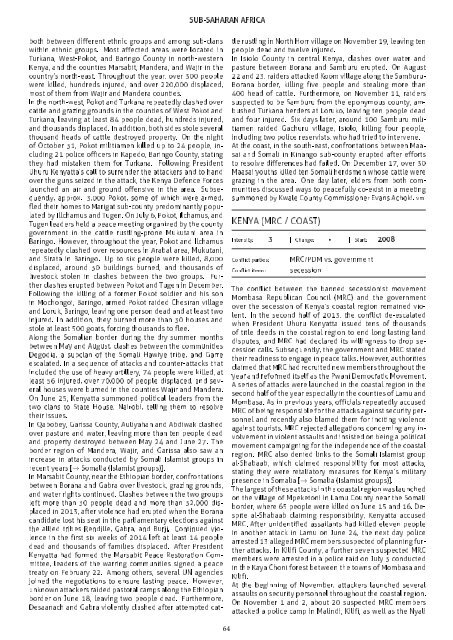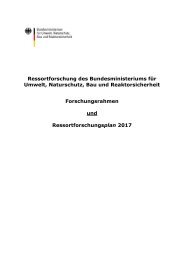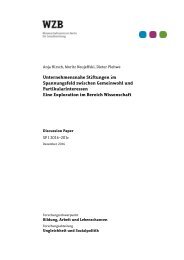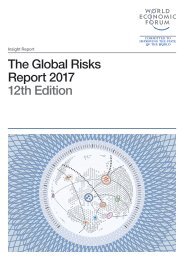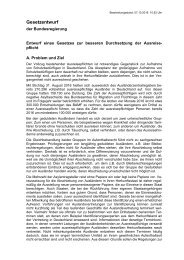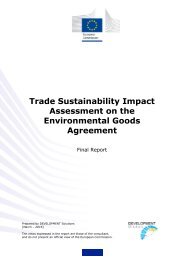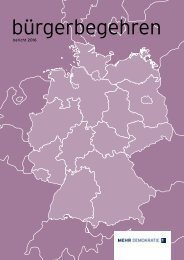79PFnGscZ
79PFnGscZ
79PFnGscZ
You also want an ePaper? Increase the reach of your titles
YUMPU automatically turns print PDFs into web optimized ePapers that Google loves.
SUB-SAHARAN AFRICA<br />
both between different ethnic groups and among sub-clans<br />
within ethnic groups. Most affected areas were located in<br />
Turkana, West-Pokot, and Baringo County in north-western<br />
Kenya, and the counties Marsabit, Mandera, and Wajir in the<br />
country's north-east. Throughout the year, over 300 people<br />
were killed, hundreds injured, and over 220,000 displaced,<br />
most of them from Wajir and Mandera counties.<br />
In the north-west, Pokot and Turkana repeatedly clashed over<br />
cattle and grazing grounds in the counties of West Pokot and<br />
Turkana, leaving at least 84 people dead, hundreds injured,<br />
and thousands displaced. In addition, both sides stole several<br />
thousand heads of cattle destroyed property. On the night<br />
of October 31, Pokot militiamen killed up to 24 people, including<br />
21 police officers in Kapedo, Baringo County, stating<br />
they had mistaken them for Turkana. Following President<br />
Uhuru Kenyatta's call to surrender the attackers and to hand<br />
over the guns seized in the attack, the Kenya Defence Forces<br />
launched an air and ground offensive in the area. Subsequently,<br />
approx. 3,000 Pokot, some of which were armed,<br />
fled their homes to Marigat sub-county predominantly populated<br />
by Illchamus and Tugen. On July 6, Pokot, Ilchamus, and<br />
Tugen leaders held a peace meeting organized by the county<br />
government in the cattle rustling-prone Mukutani area in<br />
Baringo. However, throughout the year, Pokot and Ilchamus<br />
repeatedly clashed over resources in Arabal area, Mukutani,<br />
and Sirata in Baringo. Up to six people were killed, 8,000<br />
displaced, around 30 buildings burned, and thousands of<br />
livestock stolen in clashes between the two groups. Further<br />
clashes erupted between Pokot and Tugen in December.<br />
Following the killing of a former Pokot soldier and his son<br />
in Mochongoi, Baringo, armed Pokot raided Chesiran village<br />
and Loruk, Baringo, leaving one person dead and at least two<br />
injured. In addition, they burned more than 30 houses and<br />
stole at least 500 goats, forcing thousands to flee.<br />
Along the Somalian border during the dry summer months<br />
between May and August, clashes between the communities<br />
Degodia, a subclan of the Somali Hawiye tribe, and Garre<br />
escalated. In a sequence of attacks and counter-attacks that<br />
included the use of heavy artillery, 74 people were killed, at<br />
least 56 injured, over 70,000 of people displaced, and several<br />
houses were burned in the counties Wajir and Mandera.<br />
On June 25, Kenyatta summoned political leaders from the<br />
two clans to State House, Nairobi, telling them to resolve<br />
their issues.<br />
In Qabobey, Garissa County, Auliyahan and Abdiwak clashed<br />
over pasture and water, leaving more than ten people dead<br />
and property destroyed between May 24 and June 27. The<br />
border region of Mandera, Wajir, and Garissa also saw an<br />
increase in attacks conducted by Somali Islamist groups in<br />
recent years [→ Somalia (Islamist groups)].<br />
In Marsabit County, near the Ethiopian border, confrontations<br />
between Borana and Gabra over livestock, grazing grounds,<br />
and water rights continued. Clashes between the two groups<br />
left more than 30 people dead and more than 32,000 displaced<br />
in 2013, after violence had erupted when the Borana<br />
candidate lost his seat in the parliamentary elections against<br />
the allied tribes Rendille, Gabra, and Burji. Continued violence<br />
in the first six weeks of 2014 left at least 14 people<br />
dead and thousands of families displaced. After President<br />
Kenyatta had formed the Marsabit Peace Restoration Committee,<br />
leaders of the warring communities signed a peace<br />
treaty on February 22. Among others, several UN agencies<br />
joined the negotiations to ensure lasting peace. However,<br />
unknown attackers raided pastoral camps along the Ethiopian<br />
border on June 18, leaving two people dead. Furthermore,<br />
Desaanach and Gabra violently clashed after attempted cattle<br />
rustling in North Horr village on November 19, leaving ten<br />
people dead and twelve injured.<br />
In Isiolo County in central Kenya, clashes over water and<br />
pasture between Borana and Samburu erupted. On August<br />
22 and 23, raiders attacked Koom village along the Samburu-<br />
Borana border, killing five people and stealing more than<br />
400 head of cattle. Furthermore, on November 11, raiders<br />
suspected to be Samburu from the eponymous county, ambushed<br />
Turkana herders at Loruko, leaving ten people dead<br />
and four injured. Six days later, around 100 Samburu militiamen<br />
raided Gachuru village, Isiolo, killing four people,<br />
including two police reservists, who had tried to intervene.<br />
At the coast, in the south-east, confrontations between Maasai<br />
and Somali in Kinango sub-county erupted after efforts<br />
to resolve differences had failed. On December 17, over 30<br />
Maasai youths killed ten Somali herdsmen whose cattle were<br />
grazing in the area. One day later, elders from both communities<br />
discussed ways to peacefully co-exist in a meeting<br />
summoned by Kwale County Commissioner Evans Achoki. vm<br />
KENYA (MRC / COAST)<br />
Intensity: 3 | Change: | Start: 2008<br />
Conflict parties:<br />
Conflict items:<br />
MRC/PDM vs. government<br />
secession<br />
The conflict between the banned secessionist movement<br />
Mombasa Republican Council (MRC) and the government<br />
over the secession of Kenya's coastal region remained violent.<br />
In the second half of 2013, the conflict de-escalated<br />
when President Uhuru Kenyatta issued tens of thousands<br />
of title deeds in the coastal region to end long lasting land<br />
disputes, and MRC had declared its willingness to drop secession<br />
calls. Subsequently, the government and MRC stated<br />
their readiness to engage in peace talks. However, authorities<br />
claimed that MRC had recruited new members throughout the<br />
year and reformed itself as the Pwani Democratic Movement.<br />
A series of attacks were launched in the coastal region in the<br />
second half of the year especially in the counties of Lamu and<br />
Mombasa. As in previous years, officials repeatedly accused<br />
MRC of being responsible for the attacks against security personnel<br />
and recently also blamed them for inciting violence<br />
against tourists. MRC rejected allegations concerning any involvement<br />
in violent assaults and insisted on being a political<br />
movement campaigning for the independence of the coastal<br />
region. MRC also denied links to the Somali Islamist group<br />
al-Shabaab, which claimed responsibility for most attacks,<br />
stating they were retaliatory measures for Kenya's military<br />
presence in Somalia [→ Somalia (Islamist groups)].<br />
The largest of these attacks in the coastal region was launched<br />
on the village of Mpeketoni in Lamu County near the Somali<br />
border, where 65 people were killed on June 15 and 16. Despite<br />
al-Shabaab claiming responsibility, Kenyatta accused<br />
MRC. After unidentified assailants had killed eleven people<br />
in another attack in Lamu on June 24, the next day police<br />
arrested 13 alleged MRC members suspected of planning further<br />
attacks. In Kilifi County, a further seven suspected MRC<br />
members were arrested in a police raid on July 3 conducted<br />
in the Kaya Choni forest between the towns of Mombasa and<br />
Kilifi.<br />
At the beginning of November, attackers launched several<br />
assaults on security personnel throughout the coastal region.<br />
On November 1 and 2, about 20 suspected MRC members<br />
attacked a police camp in Malindi, Kilifi, as well as the Nyali<br />
64


